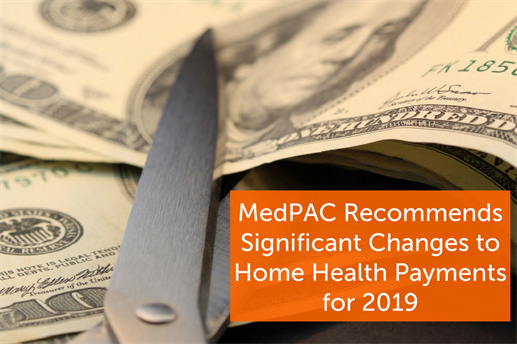Once again, MedPAC has recommended that Medicare cut payments to home health agencies.
In the annual report issued in March, the bipartisan Medicare Payment Advisory Commission, or MedPAC, recommended that CMS cut Medicare reimbursements to home health agencies by 5 percent beginning in 2019. The group also recommended that a two-year rebasing of the reimbursement system beginning in 2020, as well as eliminating therapy visits as a factor in payments. This is not the first time that MedPAC has recommended a significant cut to home health agency reimbursements; the group also recommended a 5 percent cut for 2018, which became a .4 percent cut in the final rule. This has consistently been the case, as Congress is not required to follow MedPAC’s recommendations, and typically reduces the cuts significantly.
Still, MedPAC’s recommendations have created some concern among the home health industry, which is already facing significant reimbursement reductions and slim operating margins. In the report to Congress, MedPAC outlined some the factors leading to the recommendation, not all of which home health agencies agree with.
Motivation for the Payment Reductions
MedPAC’s recommendations are based on their analysis of existing payments and how adequate they are for the care that is actually being provided. According to the March 2018 report, Medicare spent about $18.1 billion on home health care services for 3.4 million beneficiaries. This represents payments to 12,200 HHAs across the country.
The report indicates that MedPAC believes that all the factors pointing to “payment adequacy” for home health are positive. These factors include:
- Access to care. MedPAC notes that 99 percent of Medicare beneficiaries live in a ZIP code served by a home health agency, with 86 percent living in ZIP code served by five or more agencies
- Declining number of agencies. The overall number of agencies has declined by 1.2 percent since 2015, after several years of record growth
- The overall number of patient visits has declined, despite an increase in the number of people using home health
- Performance has improved on some quality measures, including walking. However, MedPAC’s finding indicate that emergency room visits and hospitalization rates were unchanged since 2016.
- HHAs have more access to capital than ever before, allowing them to invest in infrastructure (such as home health software) that supports more effective agency management.
- By MedPAC calculations, the payments have exceeded costs, in some cases by as much as a 17 percent margin, due to fewer visits per episode and annual payment updates outpacing cost growth
Taken together, MedPAC believes that home health could withstand a reduction in payments, and a 5 percent cut is in order.
A Few Concerns
MedPAC may appear to be making a solid case for its recommendations, but the data they are using doesn’t tell the entire story. For example, the idea that 99 percent of Medicare beneficiaries live in a ZIP code serviced by an HHA might be accurate, but misleading. In some rural areas, for example, an HHA may service a ZIP code that is as much as an hour or longer away.
While the right software tools can help plan provider routes to minimize driving, in places like rural New England, home health providers drive an average of 35 minutes between clients, meaning that travel costs represent a significant portion of the operating budget. So, while yes, technically a Medicare beneficiary may have access to home health services, that doesn’t necessarily mean that the agency is earning the same level of reimbursement for them.
MedPAC’s assertions about quality measures, in particular the ER visit and hospitalization rates, also directly contradict a number of major research studies, which conclusively determined that home health is an important piece of the puzzle when it comes to avoiding hospital readmissions and emergency room visits. In fact, it’s in recognition of home health’s role in keeping patients safe and at home that CMS is expanding coverage for non-skilled home health for Medicare Advantage beneficiaries. As more hospitals and health groups find ways to leverage home health into better outcomes for patients, performance on these quality measures will only continue to improve.
Finally, profit margins for home health agencies have been shrinking over the last decade, as reimbursement cuts have put the squeeze on many agencies. As industry leaders have pointed out, most government calculations of profit margins have not taken into account the need to invest in new technology, training costs, taxes, health care benefit costs, and other operating expenses, which actually leave many agencies operating at a loss. Should Congress act on MedPAC’s recommendations, the number of agencies operating at a loss — or even forced to close — could increase exponentially.
The good news is that Congress has not followed MedPAC’s recommendations in the past, and few expect them to enact a 5 percent cut this time either. However, stay tuned for more updates on this important report. And don’t forget to check out Complia Health’s family of home health agency software, and learn about technological solutions that will grow with your agency.




